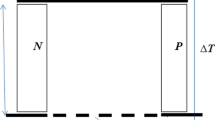Abstract
The influence of internal heat sources on temperature distribution during the operation of thermoelectric generators (TEG) is investigated. Taking into account various factors affecting the temperature regime, including internal heat sources, a multilevel model of a two-stream TEG has been developed, which allows one to calculate the temperature distribution and the integral characteristics of the generator. The calculations were carried out using the PHOENICS program package; as a result, the dependences of the electrical characteristics and the temperature drop on the junctions on the load resistance, speed, and coolant temperature were obtained. A comparison is made with the corresponding indicators in the absence of internal heat sources. It is concluded that the influence of internal heat sources on the temperature drop and electric power increases with decreasing load resistance. Thus, in the maximum power mode, which corresponds to the ratio of the load resistance to the internal resistance of the module m = 1.15, the temperature drop decreases by 3.5–4.0%, while that at m = 0.01 is by 7.5–8.5%. TEG power in maximum power mode decreases by 7.5–8.0%. Studies have shown that the influence of internal heat sources on the characteristics of the TEG is more substantial when the flow rate in the heat exchangers is lower. The greatest decrease in the values of indicators due to the influence of internal sources was observed at v = 0.2 m/s and amounted in maximum power mode to 5.5–6.0% for the temperature difference and 12–13% for power. The results obtained indicate that the influence of internal sources on the characteristics of TEGs is significant enough, which implies that the most accurate estimates of the thermal and electrical performance of TEGs can be made only by taking into account the effect of internal heat sources on the temperature distribution in TEGs.








Similar content being viewed by others
REFERENCES
S. B. Riffat and X. Ma, “Thermoelectrics: A review of present and potential applications,” Appl. Therm. Eng. 23, 913–935 (2003). https://doi.org/10.1016/S1359-4311(03)00012-7
Engineering Scoping Study of Thermoelectric Generator Systems for Industrial Waste Heat Recovery (U. S. Department of Energy, Office of Energy Efficiency and Renewable Energy, Washington, DC, 2006). https://www1. eere.energy.gov/manufacturing/industries_technologies/ imf/pdfs/teg_final_report_13.pdf
G. Fraisse, J. Ramousse, D. Sgorlon, and C. Goupil, “Comparison of different modeling approaches for thermoelectric elements,” Energy Convers. Manage. 65, 351–356 (2013). https://doi.org/10.1016/j.enconman.2012.08.022
S. Shittu, G. Li, X. Zhao, and X. Ma, “Thermoelectric generator performance enhancement by the application of pulsed heat power,” in Proc. 6th Int. Conf. of Fluid Flow, Heat and Mass Transfer, Ottawa, Canada, June 18–19,2019 (Carleton Univ., Ottawa, 2019), paper no. FFHMT 146.
T. Lu, X. Zhang, J. Zhang, P. Ning, Y. Li, and P. Niu, “Multi-objective optimization of thermoelectric cooler using genetic algorithms,” AIP Adv. 9, 095105 (2019). https://doi.org/10.1063/1.5119022
D. Mei, H. Wang, Z. Yao, and Y. Li, “Numerical modeling and optimization of the segmented PbTe–BiTebased thermoelectric leg,” J. Appl. Phys. (Melville, NY, U. S.) 120, 124503 (2016). https://doi.org/10.1063/1.4962317
S. Kumar, S. D. Heister, X. Xu, J. R. Salvador, and G. P. Meisner, “Thermoelectric generators for automotive waste heat recovery systems. Part I: Numerical modeling and baseline model analysis,” J. Electron. Mater. 42, 665–674 (2013). https://doi.org/10.1007/s11664-013-2471-9
S. C. Kaushik and S. Manikandan, “The influence of Thomson effect in the performance optimization of a two stage thermoelectric cooler,” Cryogenics 72, 57–64 (2015). https://doi.org/10.1016/j.cryogenics.2015.08.004
R. Bjørk, D. V. Christensen, D. Eriksen, and N. Pryds, “Analysis of the internal heat losses in a thermoelectric generator,” Int. J. Therm. Sci. 85, 12–20 (2014). https://doi.org/10.1016/j.ijthermalsci.2014.06.003
X. Wang and M. Lundstrom, “Limitations of zT as a figure of merit for nanostructured thermoelectric materials,” J. Appl. Phys. 126, 195703 (2019). https://doi.org/10.1063/1.5127175
J. Chen, Z. Yan, and L. Wu, “The influence of Thomson effect on the maximum power output and maximum efficiency of a thermoelectric generator,” J. Appl. Phys. (Melville, NY, U. S.) 79, 8823 (1996). https://doi.org/10.1063/1.362507
E. Massaguer, A. Massaguer, L. Montoro, and J. R. Gonzalez, “Development and validation of a new TRNSYS type for the simulation of thermoelectric generators,” App-l. Energy 134, 65–74 (2014). https://doi.org/10.1016/j.apenergy.2014.08.010
W. He, S. Wang, C. Lu, X. Zhang, and Y. Li, “Influence of different cooling methods on thermoelectric performance of an engine exhaust gas waste heat recovery system,” Appl. Energy 162, 1251–1258 (2015). https://doi.org/10.1016/j.apenergy.2015.03.036
E. Massaguer, A. Massaguer, L. Montoro, and J. R. Gonzalez, “Modeling analysis of longitudinal thermoelectric energy harvester in low temperature waste heat recovery applications,” Appl. Energy 140, 184–195 (2015). https://doi.org/10.1016/j.apenergy.2014.12.005
J.-Y. Jang, Y.-C. Tsai, and C.-W. Wu, “A study of 3-D numerical simulation and comparison with experimental results on turbulent flow of venting flue gas using thermoelectric generator modules and plate fin heat sink,” Energy 53, 270–281 (2013). https://doi.org/10.1016/j.energy.2013.03.010
J. Chen, K. Li, C. Liu, M. Li, Y. Lv, L. Jia, and S. Jiang, “Enhanced efficiency of thermoelectric generator by optimizing mechanical and electrical structures,” Energies (Basel, Switz.) 10, 1329 (2017). https://doi.org/10.3390/en10091329
B. E. Launder and D. B. Spalding, “The numerical computation of turbulent flows,” Comp. Meth. Appl. Mech. Eng. 3, 269–289 (1974). https://doi.org/10.1016/0045-7825(74)90029-2
Author information
Authors and Affiliations
Corresponding author
Rights and permissions
About this article
Cite this article
Volgin, V.S., Ginevsky, A.F. Study into the Influence of Internal Heat Sources on the Operating Characteristics of a Thermoelectric Generator. Therm. Eng. 67, 469–476 (2020). https://doi.org/10.1134/S0040601520070083
Received:
Revised:
Accepted:
Published:
Issue Date:
DOI: https://doi.org/10.1134/S0040601520070083




